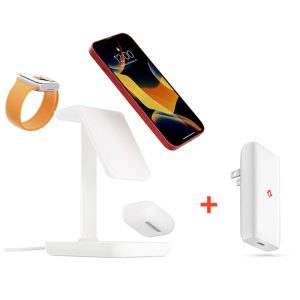Wireless Power Charger
Wireless charging is a convenient feature that eliminates the need for a wire. While the technology isn’t completely wireless—you still need a power source, whether it be a wall charger or USB port—it frees you from the cable that usually connects to your smartphone or other device.
The process is called inductive charging and relies on electromagnetic induction. It works by sending an electrical current into a metal coil in the transmitter that then induces a similar current into a battery in the receiver, which charges the battery. The technology is already used in some household appliances, such as electric toothbrushes and razors, but it’s becoming increasingly popular for smartphones and other mobile devices.

When you place your phone on a wireless power charger pad or stand, the device recognizes the inductive field and starts to charge. The power flows through the coils to your smartphone’s internal battery and your phone is powered without a cable. Wireless charging can also power small, wearable gadgets, such as earbuds and watches.
What is a Wireless Power Charger?
While the technology is fairly new, its roots go back more than 100 years to Serbian-American inventor Nikola Tesla. He demonstrated resonant inductive transmission of electricity to light bulbs in his New York City laboratory in the late 1800s, using a copper coil with a series capacitor that generated a magnetic field to transmit energy.
Today, you can buy wireless charging pads or stands that will power most recent smartphones and many other electronics, including most laptops. In the future, wireless technology may be integrated into more of your household appliances and even cars. For example, companies like WiTricity are developing technology that can allow an electric car to charge simply by parking on a charging pad or station. The company’s electromagnetic resonant technology can transfer up to 93% of the power it receives, which is more efficient than a traditional plug-in cord.
The most common wireless charging standard is Qi, developed by the Wireless Power Consortium. It has become the industry standard in most smartphones and most other electronics that support it, and has been adopted by all the major tech manufacturers. The WPC’s goal in creating the standard was to ensure interoperability between compatible devices. Other competing standards include PMA and AirfuelTM, which work on a similar principle but over different frequencies with different control algorithms.
Renesas offers a full line of WPC and PMA-compliant receiver ICs that can be designed into products to meet the requirements of any of these standards. The receivers are available in a range of output levels, from 5 V to 15 W. They are fully compliant with the three industry standards and come with powerful software tools to simplify design-in.
The transmitter ICs are based on the same core technology but are optimized for the specific requirements of each wireless power protocol. They operate from an input DC rail of 5 V to 19 V, typically derived from a step-down DC-DC switching regulator or tracking LDO. A switched transistor bridge with two or four FETs drives a coil and series capacitor to create the electromagnetic induction field.
With 15 years of unwavering dedication, TVCMALL has ascended as the eminent one-stop wholesale mobile accessories and consumer electronics shopping platform, proudly offering a vast array of over 600,000 products across 20+ lines. The close partnership with strategic partners empowers the company to update 6,000+ new arrivals weekly while providing unparalleled customization, sourcing, and dropshipping services. (Visit the website to get more experience: www.tvcmall.com)